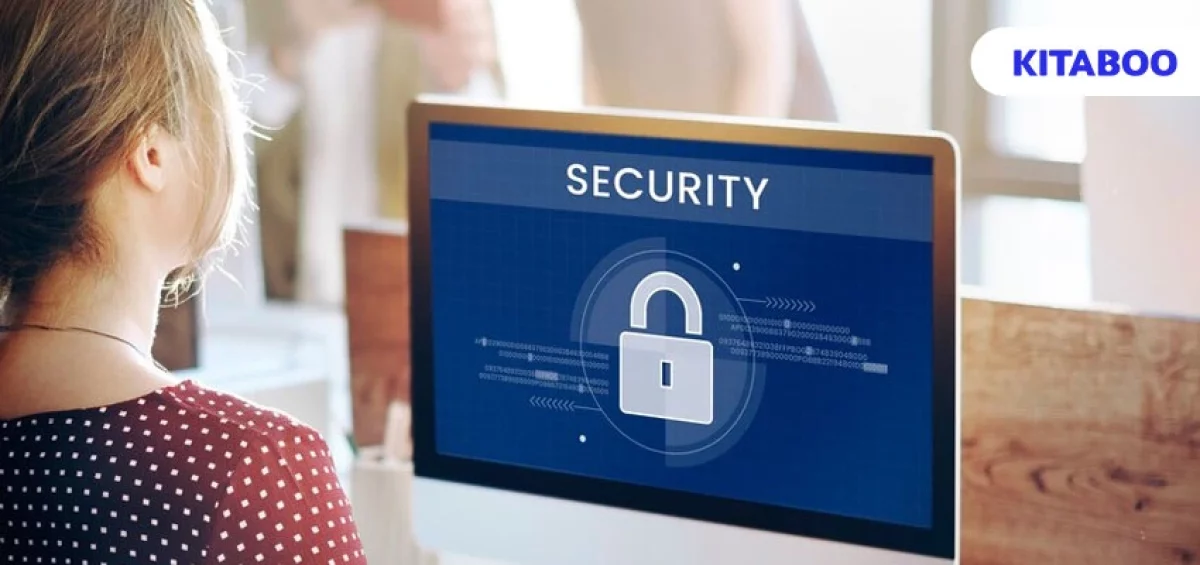Technology in every field is rapidly evolving, and education is no exception. It is imperative that Educational Technology, popularly termed as EdTech introduces stringent and robust security measures so that the safety of data and development is not compromised.
The security of educational technology depends on the platform or application it uses. It’s essential to choose and review the privacy policy and ensure a secure learning environment by using relevant data encryption practices and user authentication features. It is also recommended to trust reliable and tested digital textbook platforms like KITABOO, which guarantee innovation and security in EdTech.
However, balancing innovation and security in EdTech is not easy and there could be several challenges that technology managers of the leaders of the organization may have to face. Here is an overview of recognizing such hurdles, identifying reasons why the industry should not compromise on innovation and security in EdTech, and key strategies that can be followed to maintain and sustain it.
Table of Contents:
I. Challenges Faced by the Leaders of the Educational Industry
- Vulnerable Digital Environment
- Sensitive Student Data
- Concerns around Interoperability
- Constantly Changing Trends
- Budget Constraints
II. Strategies for Innovation and Security in EdTech
- Enhanced Learning Experiences
- Individualized Learning Based on Global Solutions
- Streamlined Administration
- Cost-Efficiency
III. 5 Key Trends in Promoting Innovation and Security in EdTech
- Develop a comprehensive security framework
- Encourage User Training and Awareness
- Foster Internal/External Collaboration
- Implement Continuous Monitoring and Updating
- Enforce Data Privacy Policies
IV. Conclusion
Challenges Faced by the Leaders of the Educational Industry
Educational technology isn’t about just driving digital solutions in the field of education. It is also about balancing profitability and social transformation while considering a sustainable environment within the industry. Key trends in the K12 tech-integrated education are using smart classrooms, offering personalized, globalized, and digitalized learning resources, improving learning via AI, maintaining data privacy and security, taking advantage of cloud-based solutions, and maintaining equity in education.
Some of the critical obstacles in the path to smooth integration of technology in education are:
1. Vulnerable Digital Environment
Educational technology is witnessing innovations at an extremely large scale in AI, cloud computing, and data analytics. Although it brings in great potential, it also comes with new vulnerabilities. It is essential to ensure that the rapid transformations introduced by digitalization don’t outpace the safety and security measures that organizations must take.
2. Sensitive Student Data
It is getting difficult for the leaders of EdTech to strike a balance between personalized learning experiences and maintaining the security of student data, which is extremely valuable. Organizations need to access necessary controls, follow stringent regulations, apply robust encryption, and apply transparent data policies to ensure the safety of student data.
3. Concerns around Interoperability
There is a hoard of EdTech tools, resources, and apps that are available in the digital market. If the applicability and collaboration of such resources do not seamlessly integrate, there could be increasing concerns around interoperability, which can eventually lead to potential security gaps. The need of the hour is to standardize efforts that can address this challenge.
4. Constantly Changing Trends
As technology evolves and trends take a new turn, it becomes essential for EdTech to stay updated on cybersecurity best practices. It is equally important to raise awareness and arrange appropriate training for students and educators to mitigate security risks.
5. Budget Constraints
One of the biggest challenges is implementing security measures in EdTech that are cost-effective, safe, and ensure long-term security solutions. Budget constraints can deteriorate the effectiveness of advanced security measures and can become a persistent challenge for many educational institutions.
It is of utmost importance for technology leaders and CPOs of EdTech to address such challenges and collaborate with genuine platforms, EdTech providers, and digital textbook platforms like KITABOO to adhere to comprehensive security standards while encouraging innovation in education.
Strategies for Innovation and Security in EdTech
Educational technology should be both innovative and secure for several compelling reasons:
1. Enhanced Learning Experiences
Innovative EdTech introduces new and engaging ways for students to learn and encourages creativity and critical thinking. Introducing innovation in AR & VR, interactive platforms, and adaptive learning technologies can enhance the overall learning experience.
2. Individualized Learning Based on Global Solutions
If the EdTech solutions are innovative and secure, it becomes easy to break down geographical barriers and provide access to educational resources for students across the globe.
This promotes equal learning opportunities and allows for personalized learning experiences tailored to individual student needs. It is further important to use data analytics to adjust content based on an individual’s pace and progress, thus optimizing the learning journey.
3. Streamlined Administration
As the world becomes increasingly digital, students need to prepare for future careers, acquire digital literacy skills, and gain proficiency in using technology effectively.
Innovative EdTech tools streamline administrative processes by mitigating manual workloads and focusing more on teaching and providing individualized support to students. This further enables real-time feedback, helps K12 learners identify areas for improvement, and contributes to a more responsive learning environment.
4. Cost-Efficiency
Security is paramount in EdTech as it can help protect sensitive student data and ensure a safe online learning environment. Robust security measures could attract some initial investments. However, it can lead to long-term cost savings.
To introduce cost efficiency, educational organizations must streamline processes, optimize resource allocation, reduce paperwork, evolve pedagogical approaches, and adapt to emerging technological trends.
5 Key Trends in Promoting Innovation and Security in EdTech
Let us look at some of the prominent trends and latest solutions that ensure innovation and security in EdTech.
1. Develop a Comprehensive Security Framework
When designing and developing EdTech solutions, leaders and technology managers need to integrate a comprehensive security framework to avoid data breaches and unauthorized access.
It is important to assess risks, implement robust encryption protocols, define and enforce strict access controls, implement multi-factor authentication for users, and conduct regular audits. Leaders of EdTech must also adhere to strict coding practices and educate users about cybersecurity best practices.
2. Encourage User Training and Awareness
Educators and students need to be aware of cybercrime, data theft, and phishing attempts before they start using digitized resources. They must understand the essence of securing personal and educational data.
You can develop interactive online training modules and gamification elements to make such training engaging and fun. Regular workshops, security awareness campaigns, and webinars can educate all stakeholders about the threats and tell them how to use digital environments safely.
3. Foster Internal/External Collaboration
It becomes important to partner with cybersecurity experts and research institutions to focus on advanced technology solutions for educational security challenges. There are several industry forums and conferences that you can participate in.
Collaborating with external organizations or digital textbook platforms like KITABOO can leverage expertise and adapt security measures. Even internal collaborations between educators, IT professionals, and security experts can establish industry standards for security.
4. Implement Continuous Monitoring and Updating
Leaders of EdTech must establish a robust monitoring system to actively track user activities, the performance of the system, and potential security incidents. They must use data analytics to gain insights into user preferences and potential security risks.
Another way to promote innovative features and security enhancements is to encourage users to provide feedback through surveys or other channels so you can update software and systems to bridge the gap.
5. Enforce Data Privacy Policies
The leaders of EdTech must ensure that policies are drafted to encourage users to have complete control over their data, which is exclusively used for educational purposes. The framework of such policies should define an incident response plan, define ways to act in the event of a security breach, and be compliant with relevant data protection regulations.
It should also ensure that the infrastructure can adapt to new security requirements without compromising functionality. Finally, it is highly recommended to regularly review and update these policies to align with evolving privacy regulations.
Conclusion
Adapting to key trends in educational technology can revolutionize the sector by combining innovation and security in EdTech. It provides dynamic, personalized, and secure learning experiences that prepare K12 learners for the challenges of the modern world. Educational organizations must adopt a proactive and multi-faceted security approach and encourage creativity and innovations so that they can harness maximum benefits.
You can contact the professionals at KITABOO, one of the most popular digital textbook platforms, to empower leaders with the latest trends in innovation and security in EdTech.
Write to us at KITABOO@hurix.com to know more.
Suggested Reads:
- HOW TO GUIDE: How to Merge Google Classroom with Content Delivery Platform
- Workplace Health and Safety Training – Employer Responsibilities
- 5 Reasons Why Publishers should opt for eBook Distribution Services
- 11 Best Apps to Read PDF Books on Android Devices
- Can US Higher Education Publishers Leverage a Subscription Model
Discover How An Ebook Conversion, Publishing & Distribution Platform Can Help You
Kitaboo is a cloud-based content platform to create-publish & securely distribute interactive mobile-ready ebooks.
You May Also Like
-
Interactive eBook: Engaging Readers in a Digital Age
Blog,Digital Publishing,eBook solution / February 29, 2024










